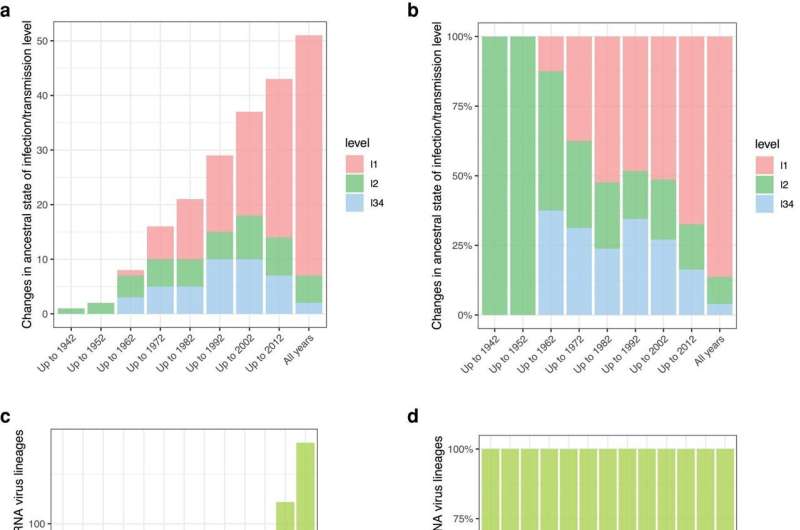This article has been reviewed according to Science X's editorial process and policies. Editors have highlighted the following attributes while ensuring the content's credibility:
fact-checked
trusted source
proofread
Virus ancestry could help predict next pandemic

Virus family history could help scientists identify which strains have the potential to become the so-called Disease X that causes the next global pandemic.
A new study published in Molecular Biology and Evolution has identified 70 virus lineages—groups of related viruses—that pose the biggest risk. Viruses from other genetic backgrounds are unlikely to cause a high number of infections in humans, the research shows.
The findings will support ongoing efforts to monitor and prepare for future pandemics, including guiding vaccine and diagnostic development, experts say.
Disease X
Disease X is the generic term used by the World Health Organization to represent a hypothetical, unidentified pathogen that could pose a significant threat to people.
RNA viruses carry their genetic information as RNA, a structure similar to DNA. They cause many diseases, including the common cold, COVID-19 and measles, and have been responsible for most epidemics, or global pandemics, in recent history.
Monitoring RNA viruses in animal populations could help to identify those that are most likely to emerge and spread rapidly in humans. However, the huge number in circulation makes this extremely challenging and expensive.
Virus evolution
The University of Edinburgh-led research team traced the lineage, or family tree, of 743 distinct RNA virus species to track how they evolved, including all species currently known to infect humans.
Researchers compared the development of strictly zoonotic viruses—those that spread from animals to humans, but not between people—with human-transmissible viruses, which can spread within human populations.
Human transmission
The findings showed that viruses that can spread within human populations typically evolve separately from strictly zoonotic viruses.
Human-transmissible viruses often emerge when related viruses from the same lineage can already spread between humans.
Strictly zoonotic viruses have historically not led to epidemics in human populations. Having a close relative that can infect humans, but not spread between them, does not appear to increase the risk of epidemic potential.
Streamline surveillance
The research team caution that there is still a chance the next pandemic could come as the result of a strictly zoonotic virus—such as bird flu—or an entirely new virus. However, the findings offer a route to help streamline surveillance for Disease X among the vast number of RNA viruses in existence.
"Viruses without the right ancestry don't seem to cause epidemics. Out of potentially huge numbers of mammal and bird viruses in circulation, we should concentrate on the ones that are related to existing human viruses with epidemic potential. This research narrows the search for the next Disease X enormously," says Professor Mark Woolhouse.
More information: Lu Lu et al, Temporal Dynamics, Discovery, and Emergence of Human-Transmissible RNA Viruses, Molecular Biology and Evolution (2024). DOI: 10.1093/molbev/msad272
Provided by University of Edinburgh





















